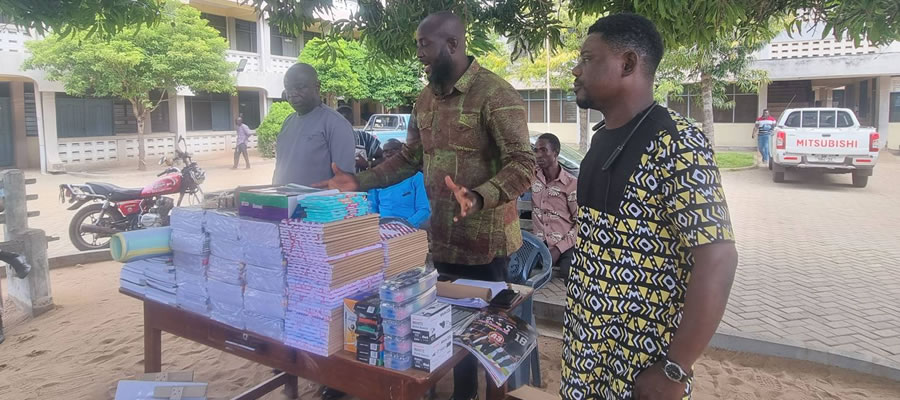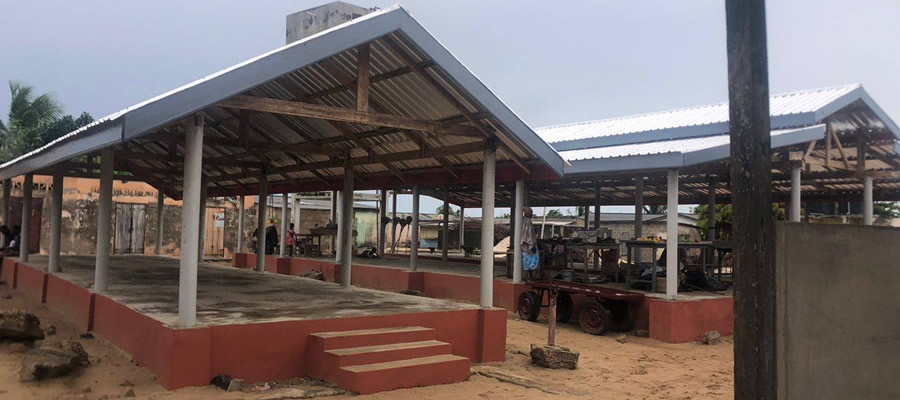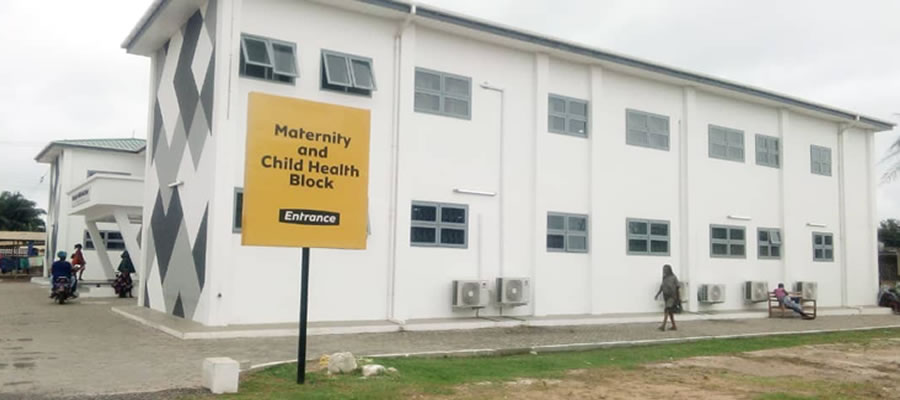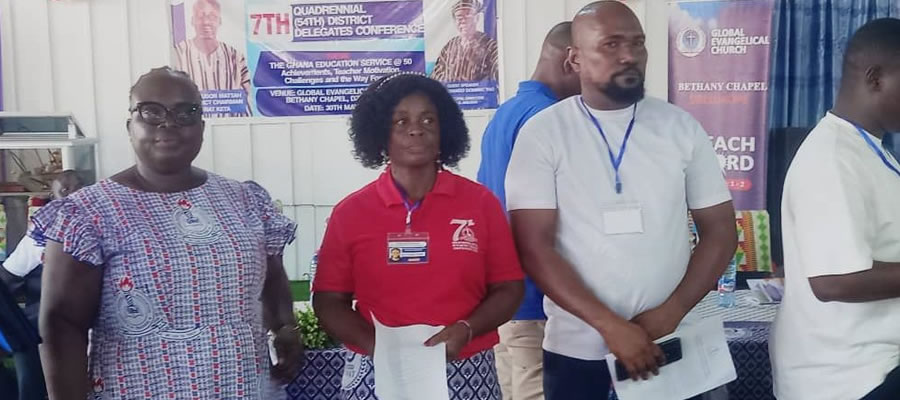

Traditional Administration
Keta South Municipal is fortunate to have one main ethnic group (Anlo), which minimizes potential conflicts resulting from multi ethnicity. The Anlo Traditional Council is headed by a paramount chief, the Awoamefia of Anlo who serves as a symbol of unity among all people in the Municipality. There are other chiefs with their own areas of influence who assist the Awoamefia in the promotion of peace and stability in the Municipality. Unlike many traditional areas in the country where pockets of chieftaincy disputes have led to constant violence, which disrupts orderly development, Keta Municipal is devoid of such atrocities.
The Assembly has therefore utilized this good traditional legacy of the Municipality to promote peace and tranquillity for effective development .Currently, with the death of the Awoamefia of Anlo Togbi Adeladza IV, the succession, to the throne has so far generated misunderstanding and division among the Anlos and the royal lineage. The seemingly negative development and its ramification is purported to be affecting unity of people and development in general in the Municipality.
The Shrines
Visits to the numerous shrines found in the Municipality do offer additional opportunities for tourism. The significant ones are Yewe, Afa, Hogbato Nyigbla, Korku, Atigare, Blekete and Fofui. Most of these cults came with the people from Notsie. Each of these cults has moral values which are of great significance to the followers.
Historical Monuments and Places
There are a number of historical monuments and places, which offer additional opportunities for learning about the historical heritage of the people.
Fort Prinzenstein: This Danish Fort build in 1784 at Keta is one of the most spectacular relics of colonialism in the Municipality. It played a key role in the infamous triangular slave trade involving West Africa, England and North America. Efforts need to be made to save this important historical monument from total destruction by sea waves and to preserve it as an important tourist resort.
The Atorkor Slave Market: In addition to Keta, Atorkor was the second slave market in the Municipality. The trade was masterminded by one Ndorkutsu. A monument was raised in the area where this wicked activity took place. The Keta Municipal Assembly intends to convert the place into an important tourist resort. A beginning has been made with the construction of a sculpture showing a slave dealer giving orders to slaves with a whip.
Anlo Military Headquarters Tsiame:- This is yet another important tourist spot where the Anlos during their historical wars gathered to plan war strategies against their enemies. It is located at Tsiame, north of Keta and at that very spot today, stands a grove, which tourists can visit.
Cape St. Paul Light House-Woe:-This is an ancient light house located at Woe near Keta. While it is still functioning, this light house directs ships at night away from what is believed to be a big submerged mountain just off the coast of Woe.
Cultural Drumming:There are several cultural drumming groups which can entertain tourists visiting the Municipality These groups include Kinka, Agbadza, Gahu, Akpaluviawo Atsuborta, Nyayito and Gakpa.
Family Cemeteries:-Other interesting attractions worth noting are the cemeteries of some families. Depending on the deceased’s background, a chief would have a statue of a chief moulded on his grave; similarly, a chief-fisherman would have a statue depicting his occupational pursuit moulded on his grave.
Keta South Municipal is one of the 170 Districts,Municipal and Metropolitan Assemblies in the country. It was established by L.I. 1475 by the PNDC Law 207 in 1989. The Local Government Act of 1993, Act 462, later replaced these laws. It is the highest political, administrative and planning authority in the Municipal. It has 14 Urban, Town and Area Councils. These councils are supposed to implement the decisions of the District Assembly and see to the day-to-day administration of their Areas of influence.
Under the Local Government Law, Act 462 of 1993, twenty-two Central Government Departments are supposed to be decentralized and reorganized into eleven Municipal Assembly Departments as shown in (Table 94). (First schedule). It must be pointed out however that the decentralization policy has not been fully implemented in Keta South Municipal because of several reasons.
A major reason is Fiscal Decentralization, which has not been done. Most of the 22 Central Government Departments continue to depend on their Regional and Head offices for funds to run their various departments. In addition, a Legislative Instrument (L.I.) which is to be issued to address concerns like recruitment, training, promotion, transfers and discipline in the re-organized departments has not been issued by the Ministry of Local Government and Rural Development.
A Local Government Service, which is supposed to be established by an Act of Parliament, is yet to be operational (Local Government Act, 1993, Act 462 Section 37, 38). Therefore, legally officials of the Decentralized Departments are not obliged to work with the Municipal Assembly and abide by its regulation.
This, to a large extent affects the effective administration of the Municipal. Keta South Municipal has absorbed some departments into its administration through the provision of office accommodation to some of them and involving others in its day-to-day activities.
Notable among the departments which have practically been “absorbed” by Keta South Municipal Assembly include the following:-
1. All Departments of the Ministry of Agriculture
2. Town and Country Planning Department
3. Department of Community Development
4. Department of Co-operativesnt of Social Welfare
11. Statistical Services.
12. Department of Parks and Gardens
13. Office of the National Youth Organization Commission
14. Department of Game and Wildlife
15. Department of Social Welfare
Tourism
Another important economic potential which has only a little of it exploited, is that of tourism. The Municipal has a lot of tourist attractions such as the clam water bodies around the Volta estuary, the extensive Keta Lagoon, the numerous creeks, the beautiful sandy beaches, lagoons and items of historical significance. These need to be promoted by dotting the landscape with rest-stops, guesthouses and holiday resorts for the expansion of tourism in the area.
As a low lying coastal plain with the highest point of only 53 metres above sea level interspersed with lagoons, creeks and mangrove forests, the Keta Municipality offers a great potential for tourism development in the country. With the recent expansion in tourist receptive facilities, one expects a corresponding increase in tourist attractions like the development of water sports, coconut groves, cultural tourism and many others.
Tourism Potentials
The Keta Municipal is very rich in tourist attractions, which are both natural and cultural.
Natural Tourism Potentials
Water Bodies and Associated Life Forms:
The sea along the coast of Keta Municipal is quite boisterous but has great potential for tourism development. The high waves are ideal for surf riding and wind surfing. The windy atmosphere also promotes the setting up of recreational facilities along the beach for tourists. The shelf is also extremely rich in predatory fishes such as barracuda, sharks, blue marlin, salt fish, horse mackerel, anchovies, sardines and sardinella.
There is also a variety of shell fish including crabs, squid or cuttle fish, lobsters and shrimps. Other sea creatures such as dolphins and in some cases sea cows can be found in the waters. The Keta Municipal harbours highly endangered species such as turtles.
Lagoons: The lagoons also provide calm water bodies for cruising and other water sports. The lagoons offer opportunities for angling since they are rich in tilapia, mudfish and others such as crabs, shrimps and scallop.
Hotels
The Keta District has a number of visitor receptive facilities such as hotels and guest houses. These facilities range from budget, hostels to one of international standards like Lorneh Hotel at Tegbi, near the beaAbutia Guest House:Located at Woe-Abutia near Keta, this facility has nineteen rooms, which are well kept. There is a security car park and a spacious drinking bar.
Keta Beach Hotel: The Keta Beach Hotel, a one-star hotel, is situated within the serene residential area of Keta. Its facilities include self-contained rooms with TV/Fans, Air Conditioners and a restaurant and bar service in addition to a conference hall and communication facilit`ies.
Lorneh Lodge Tegbi: Situated at Tegbi, is an ultra modern hotel facility with an extra-ordinary scenic beauty. It has twenty self-contained rooms with TV/video, split-unit air conditioners, soft-carpet, fridge and telephone facilities. Complementary facilities include beach resort, swimming pool and a conference hall among others.
Guadze Guest House is another visitor’s receptive facility in the district. With the air of simplicity, this guesthouse is designed to meet the comfort of the middle class of visitors. It has seven rooms with self-contained and shared facilities. Bar and restaurant services are also available.
Loreta Guest House which is at Tegbi is yet another receptive facility in the District. There are five furnished rooms with shared facilities available.
Agblor Lodge is rather a small but compact hotel with five rooms each well-furnished with TV, fan. A small bar is run to enhance visitors’ comfort.
Royal Super Five Guest House which is located at Anloga is also a visitor receptive facility. The latest guest house is the Tsisa Guest House situated at Dzelukope. It has eight well-furnished rooms.10. KDA Restaurant: This is a restaurant constructed by Keta District Assembly in 2000. It has been contracted out to a private caterer who is running it and paying rent to Keta District Assembly.
KDA Restaurant: This is a restaurant constructed by Keta District Assembly in 2000. It has been contracted out to a private caterer who is running it and paying rent to Keta District Assembly. The restaurant has improved catering facilities in the District. Tourists and residents alike have access to catering facilities which compare favourably with others at Ho, and other district capitals in the Region and the Country as a whole.
Date Created : 11/21/2017 3:57:29 AM










 facebook
facebook
 twitter
twitter
 Youtube
Youtube
 +233 593 831 280
+233 593 831 280 0800 430 430
0800 430 430 GPS: GE-231-4383
GPS: GE-231-4383 info@ghanadistricts.com
info@ghanadistricts.com Box GP1044, Accra, Ghana
Box GP1044, Accra, Ghana